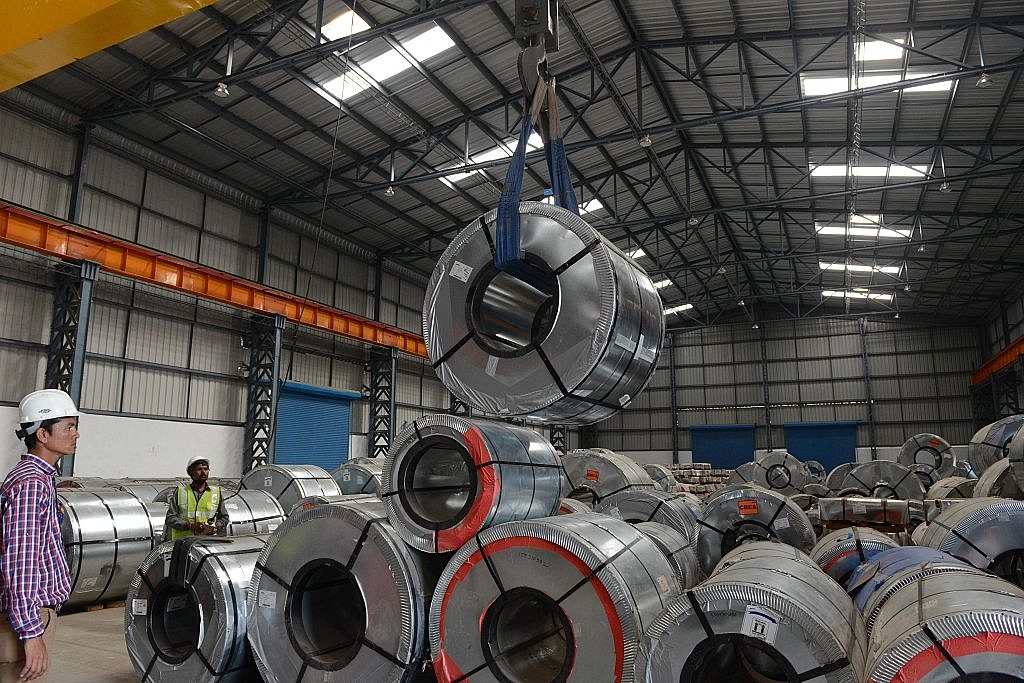Economy
The 5.7 Per Cent IIP Growth Of November Is Bunkum; On The Contrary It Confirms Slowdown
- Here’s why the industrial output data for November 2016 may not be as rosy as they appear.

Indian workers store steel coils unloaded at a new private freight terminal near Ahmedabad. (SAM PANTHAKY/AFP/GettyImages)
It is important not to get carried away by the upbeat Index of Industrial Production (IIP) numbers for November 2016, the first month of demonetisation (DeMo). The 5.7 per cent rise over the corresponding month in the previous year is a statistical blip, created by the sharp crash in the index in November 2015.
Look not at the percentage figures and examine instead the raw index numbers. In 2015, the IIP dived from 181.4 to 166.4 between October and November before rising again in December to 184.2. It is the low base effect of November 2015 that is showing up in the higher growth of November 2016. This does not prove that DeMo did not impact output in its first month.
In fact, it is equally possible to claim that the slowdown predated DeMo, and DeMo may get an undeserved share of the blame.
If one looks at the overall trend in the IIP from early 2016, the index hit the high notes in May and June, when it ruled around 182-183, but after that it has been mostly downhill, with September – when IIP revived after two weak months due to the oncoming festival season – being the lone exception. The index resumed its downward journey after that. From September’s 179.4, the index slowed to 178.1 in October, and descended to 175.8 in November, which does not read like growth whichever way you look at it.
The point that the NDA government needs to acknowledge is that the real impact of DeMo may be felt in December 2016 and January and 2017, when the cash crisis really started biting hard, and people postponed purchase decisions.
This is reflected in December’s automobile sales, which dropped nearly 19 per cent over the previous December, thanks largely to a spectacular drop in two-wheelers by a massive 22 per cent. Cars fell by 8 per cent, indicating that the impact here will be smaller than in the rural and cash-dependent two-wheeler segment.
Looking at the crystal-ball, it is possible to suggest that December and January will be the worst impacted months of DeMo, after which the recovery should begin. The GDP impact of DeMo should be reflected in the third and fourth quarters of 2016-17, after which there should be a good revival.
The IIP’s April-November details also tell the same story – of the main index pointing in the wrong direction in November. Capital goods, a lumpy and unreliable number at the best of times, rose 15 per cent in November, but this needs to be contrasted with the overall 18 per cent decline in April-November. No sir, investment does not show any revival as yet.
Barring intermediate goods, the remaining sub-indices – basic goods, capital goods, and consumer goods – show a reading in November 2016 that is higher than the April-November aggregate. November is the joker in the pack.
A sober assessment should tell Finance Minister Arun Jaitley that industry has been sluggish even before DeMo, and DeMo could not have helped. He should thus focus his budget, due on 1 February (assuming the Election Commission does not throw a spanner in the works) on providing a sensible fiscal stimulus of tax cuts and selective short-term indirect tax incentives.
His problem is that the structural problems bedevilling growth – weak banks, over-leveraged balance-sheets, under-productive agriculture, the threat of automation and unreformed factor markets (land and labour) – will now be blamed on DeMo.
Introducing ElectionsHQ + 50 Ground Reports Project
The 2024 elections might seem easy to guess, but there are some important questions that shouldn't be missed.
Do freebies still sway voters? Do people prioritise infrastructure when voting? How will Punjab vote?
The answers to these questions provide great insights into where we, as a country, are headed in the years to come.
Swarajya is starting a project with an aim to do 50 solid ground stories and a smart commentary service on WhatsApp, a one-of-a-kind. We'd love your support during this election season.
Click below to contribute.
Latest